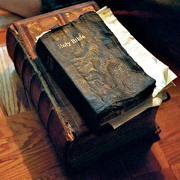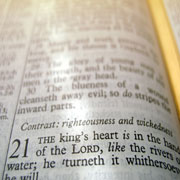
Clothes Make the Man...or do They? |
|---|
 |
The hem of a Jew's garment was not just a simple fold of the garment, doubled over and sewn down to prevent the edge from fraying. It was an ornamental highlight which made a statement about the rank and significance of the wearer. The removal of the fringe of a man's garment was the equivalent of removing part of his personality . To cut off the hem of a wife's garment was regarded as divorcing her. Fringes of garments were used in a similar manner to a signature or personal seal. The hem or fringe of a garment indicated the position or individuality of the wearer. Jesus rebuked the Pharisees for enlarging the borders (fringes) of their garments.
The obvious deduction being that they were thereby trying to make themselves look more "important". The tassels on the fringes were formed by the threads decorating the fringe being brought together at the corners of the garment and knotted. The original purpose of the fringe and tassels as stated in the law became obscured in course of time, becoming a more of a tradition, than anything else. In the Old Testament account, David spared Saul's life in a cave, but he took away the verification that he had him in his power:
Why did David cut off part of Saul's clothes? Why did his conscience bother him after he cut of the garment? There was special significance in the act of cutting off the hem (fringe) of Saul's clothes, which Saul was not slow to recognize.
David had robbed Saul of his status symbol, his "signature", "his personal seal", his rank and his significance; the fringe of Saul's robe that identified him as king. |
|
The first mention of fringes and tassels in Scripture occurs in the book of Numbers, where the people were instructed to include a special feature in their tassels; a cord of blue. This blue thread was to remind the wearer (and the observer) to "remember all the commandments of the LORD and to do them".
Even though the blue they used was of a violet shade, it was to represent the people's connection with God in heaven, the heavenly instructions they had received and the law of the LORD. Why was there to be only one cord of blue? Why not all blue? The reason is simple and practical. The blue dye was extraordinarily expensive and difficult to obtain. Blue cloth could only be afforded by the very rich and by kings. The average Hebrew would even find it difficult to acquire even a small length of the blue cord. Other Scriptures as well, clearly have a bearing on this subject. For example, in the interesting and romantic account of Ruth and Boaz, it was evidently significant what Ruth said to Boaz, when he discovered her at his feet in the morning,
The skirt of Boaz would doubtless be edged with the fringe and tassels that indicated his status. This request by Ruth was for his protection and his care as symbolized by his personal fringe - his status symbol. It is interesting to note that a similar custom still prevails at an orthodox Jewish wedding, when the bridegroom covers his bride with his tallit, his prayer shawl, with its tassels at each corner, signifying that he is taking her into his care. A modern day tallit is seen in the figure below. |
 |
One of the best known miracles of healing that Jesus performed was the occasion when a woman who had suffered from a hemorrhage for twelve years came up behind him and touched the fringe of his garment.
Why should she stoop to touch the fringe? Why not his arm, his feet or his hands? Surely it must have been because the fringe had some special significance as the emblem of Jesus' status and authority, even though it was not enlarged like those of Scribes and Pharisees. |
 |
Not only the woman thought that the hem of Jesus garment was important. This was the opinion of many other people as well.
There must have been an understanding that the fringe of the garment that Jesus wore had a very special significance. Could it be that there was a blue cord present and that cord was a reminder to them of heaven, and that they could appreciate that Jesus' power was divine power? We have no other information about the garment that Jesus wore, until his death, when it was revealed as a seamless garment, specially woven with great skill. Blue, purple and red were colors utilized by the Hebrews for various uses. Numbers chapter 4 describes uses for these three colors. The blue color that was used to cover the Tabernacle furniture before it could be removed to a new location was almost certainly what we would call violet, or bluish-purple, while the purple used for the embroidery would be a reddish-purple, and the scarlet a true bright red. These three basic colors as used for the priest's garments and the hangings of the Tabernacle were all particularly expensive, and were all obtained from small living creatures. |
 |
The blue was only obtained from the hypobranchial gland of a Murex marine snail that only lives in deep water in the Mediterranean. The purple was obtained from another variety of Murex snail that could be gathered in shallow coastal waters of the Aegean and Mediterranean Seas. The scarlet was produced from a tiny insect that infested oak trees something like the cochineal insect of the Americas, shown below on a prickly pear cactus. |
 |
Cochineal insects are soft-bodied, flat, oval-shaped insects (mealy bugs) that cluster on plants and suck out their juices. Cochineal is also the name of the crimson or carmine color dye , made from the dried bodies of the females or the crushed eggs of the species. The coloring comes from carminic acid. These insects had to be collected by hand, dried and ground to a paste to produce the scarlet dye. The production of all these dyes was very labor intensive. They were all found in very limited localities and were thus highly prized and highly priced. It has been calculated that it would take 10,000 snails to produce one gram of the blue dye. The purple dye was more readily obtained, but still very limited. Traders traveled hundreds of miles by sea and by land, to obtain or sell these limited supplies. The normal clothing of the people of Israel was of undyed linen, woven from the fibers of the flax plant. Wool would be obtained from their own flocks of sheep. When the people were asked to offer their precious possessions for the construction of the Tabernacle, a distinction was made between the colored material and the fine twined linen. It seems most likely that this distinction was between dyed woolen yarn and undyed linen. Thus, it seems probable that the embroidery work was of dyed woolen yarn worked upon plain linen cloth. This seems to be confirmed by recent studies which suggest that these dyes could only be made permanent in wool and were not fast in linen. It has been objected that to use dyed wool upon a linen cloth would have contravened the law that forbade the mixing of linen and wool. However this combination of linen and wool teaches a divine lesson. Just as a Jew was not to marry a Gentile, an ass and an ox were not to be yoked together, so linen and wool were not to be mingled in the weaving of cloth. The lesson was to be a continual reminder to Israel of their need to remain a separate people, holy to their God. It was a form of moral visual aid. Recently light has been shed upon this subject by an unexpected archaeological discovery. In the Bar Kochba caves by the Dead Sea, tassels have been found which were adequately well preserved to reveal that they were composed of linen threads with a cord of blue wool. It is now realized that the prohibition of mixing linen and wool only applied to the weaving process, and not to the added embroidery of the fringe and the tassels. The dyed woolen embroidery may therefore be symbolic of the need for a divine infusion of holiness (blue-remember Numbers 15) and royalty (purple) into the ordinary Hebrew living in Israel. The production of blue yarn and cloth dyed in the traditional way ceased many centuries ago, when the supply of snails appeared to become extinct. Jews have never been willing to accept any other kind of blue dye, so that to this day they have no blue cord in their fringes and tassels. Imagine therefore the excitement in orthodox Jewry, when, recently it was announced that the Murex snails were not extinct after all, and it might be possible to resume production of the traditional blue dye. The Roman historian Pliny described in some detail how these dyes were manufactured in his day, and attempts to follow his method have been tried by a scientific group in the Lebanon. The flurry of excitement among those Jews anxious to be able to comply with the requirements of the Law and once again have a blue cord in their fringe and tassels may speed the efforts of those engaged in this enterprise. Some Jews have even gone so far as to see the revival of the "heavenly" blue as a sure sign of the advent of their Messiah.
|
As always, remember. Be blessed and meditate or meditate and be blessed!!!!.. the choice is yours!! |
Are we Living in the Last Days...End Times? See Breaking News |
 |
| __________________________ |
 |
________________________ |
| ________________________ |
As You Study the Biblical Last Days in the News... Discover the Bible As Well |
 |
| ________________________ |
 |
| ________________________ |
 |
| ________________________ |
To Know God's Word Read Scripture |
 |
_______________________ |
To Read God's Word Your Reading Schedule |
 |
_______________________ |
 |
| _________________________ |
Thought Provoking Articles for Your Meditation |
 |
_______________________ |
